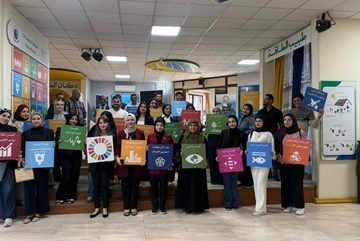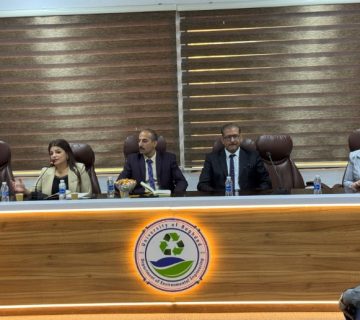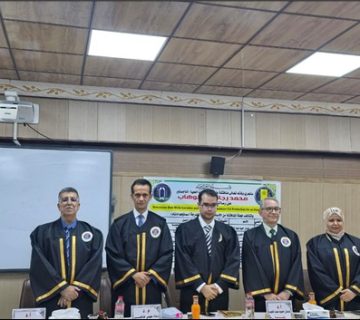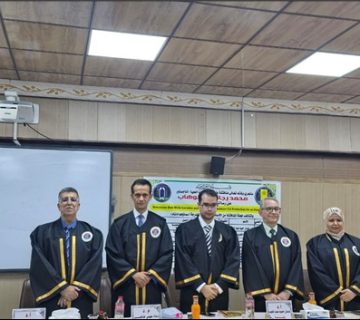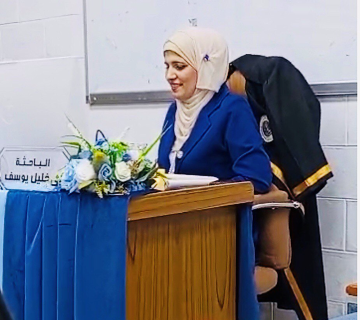Environmental Engineering Department at the College of Engineering, University of Baghdad, held PhD dissertation examination titled:
“Green approach for removal of Cd and moxifloxacin from aqueous solutions by supported magnetic nanoparticles fabricated by using cucumber peel extract”
By the student Ahmed Adel Naji and supervised Prof.Dr. Zyad Tariq Abd-Ali on Tuesday 22/10/2024, in the Environmental Engineering discussion hall. The examination committee consisted of Prof.Dr. Zainab Zyad Ismail as Chairman, and the membership of Prof.Dr. Alaa Karim Mohammed, Prof.Dr. Shahla Ismail Ibrahim, Prof.Dr. Abeer Ibrahim Mousa, and Assist.Prof.Dr. Salaah Lafta Farhan. After conducting the public discussion and listening to the student’s defense, the dissertation was accepted. It was summarized as follows:
The Environment in general can be defined as the zone, conditions, or influences that affect the life of all living things, including humans, therefore, the responsibility of all is keep this environment clean and free of contaminants through correct and successful environmental management in all behaviors. From this standpoint, this study was directed to apply eco-friendly approach through manufacture magnetite nanoparticles (MNPs) using a green co-precipitation method and immobilized onto a solid inert support (sand) to enhance their applicability for environmental remediation. The eco-friendly synthesis approach which included using agricultural wastes in producing the reducing agent aimed to eliminate the utilization of hazardous chemicals, cut down on energy use, and encourage sustainable practice in the fabrication of the nano-adsorbent. The immobilized magnetite nanoparticles (S-MNPs) were evaluated for their effectiveness in removing cadmium (Cd(II)), a heavy metal ion, and moxifloxacin (MFX), an antibiotic, from aqueous solutions in both batch and column reactor systems.
The study involved a systematic procedure to optimize the synthesis process and, subsequently, optimizing the properties of the prepared nanocomposite prior to their use. It was found that cucumber extract (out of seven types) had the higher reduction ability at 5 mL/100 mL addition amount. The contaminants adsorbed well on S-MNP fabricated with 1.5:1 of Fe3+: Fe2+ initial molar ratio and pH 12 and coated on 30 g of sand (0.3-0.6 mm). Characterization techniques, including XRD, FTIR, VSM, BET, BJH SEM, EDX and TEM, were employed to confirm the successful synthesis and immobilization of the MNPs, and to examine their structural and morphological properties. Batch adsorption studies revealed that the MNPs exhibited high adsorption capacities for both contaminants (80% for Cd(II) and 96% for MFX). The equilibrium point was attained after 90 min of the removal process time. The batch mode involved investigation of contaminants sorption at different ranges of pH (3–7 and 3–12 for Cd(II) and MFX, respectively), agitation speed (0-250 rpm), pollutant initial amount (Co, 50-250 mg/L) and nanocomposite dosage (0.05-1 g/100 mL). The best values of these parameters were (at pH 6 for Cd(II) and 9 for MFX): agitation speed = 200 rpm and Co = 50 mg/L and S-MNP dosage = 0.8 and 0.6 g/100mL for Cd(II) and MFX, respectively, which was further validated through kinetic and isotherm models. It was found that the Freundlich isotherm was best representative for the obtained data along with pseudo-second-order kinetic model. Thermodynamic analysis indicated that the adsorption processes were spontaneous and endothermic in nature, suggesting strong interactions between the MNPs and the contaminants. Furthermore, the reusability of the immobilized MNPs was tested, showing good performance over multiple cycles, thus highlighting their potential for sustainable water treatment applications. The column studies demonstrated the practical applicability of immobilized MNPs for continuous water treatment, with promising results in terms of hydraulic conductivity, breakthrough curves and removal efficiency. The results of this study further expand the current research focused on green synthesis and the practical application of nanomaterials in environmental cleanup, emphasizing the importance of sustainable practices in the development of effective remediation technologies.
The recommendations of this dissertation:
- Explore the possibility of using alternatives for Fe ions precursors that are based on iron recovery from industrial waste, in the synthesis process rather than using readily available iron salts.
- Promote for the adoption of green methodologies in producing other types of adsorbents and abandoning the environmentally harmful conventional techniques that are highly reliant on hazardous materials.
- Study the continuous removal in other configurations of fixed bed (the two-dimensional system). This configuration can provide different insights and potentially offer enhanced performance.
- This study can be extended to consider multi-components by exploring the simultaneous removal of both contaminants in binary systems.



